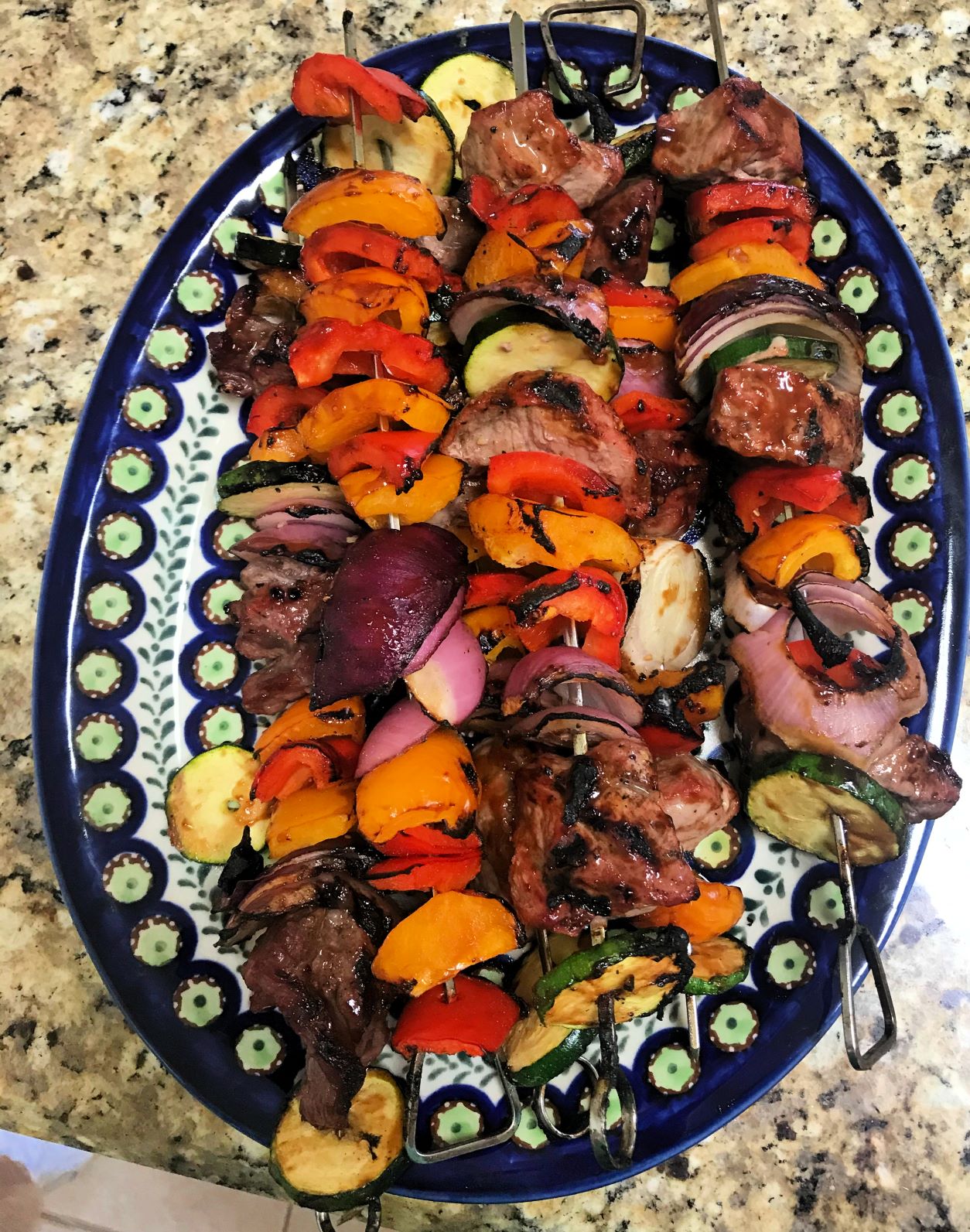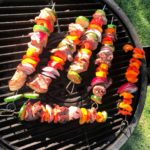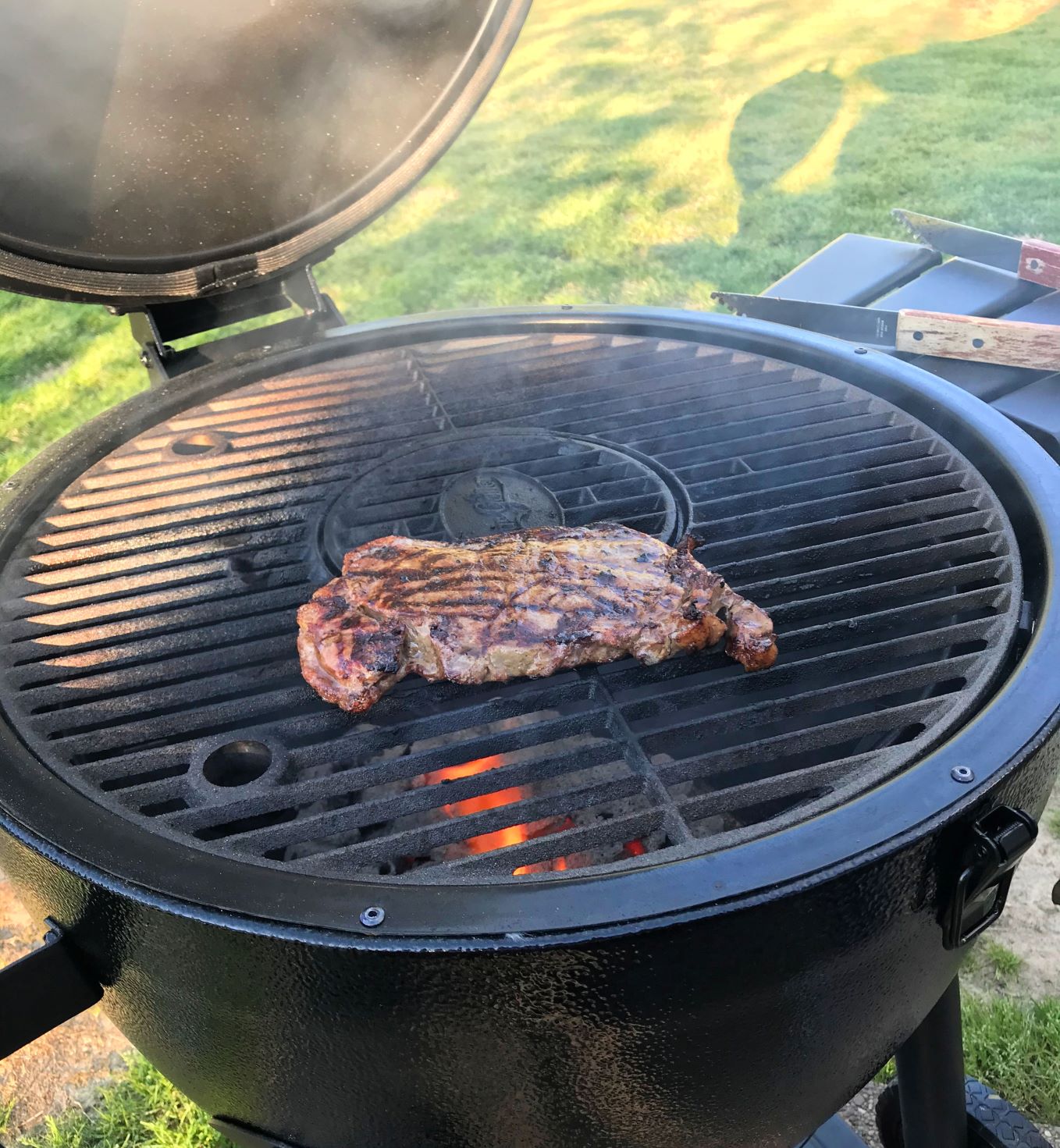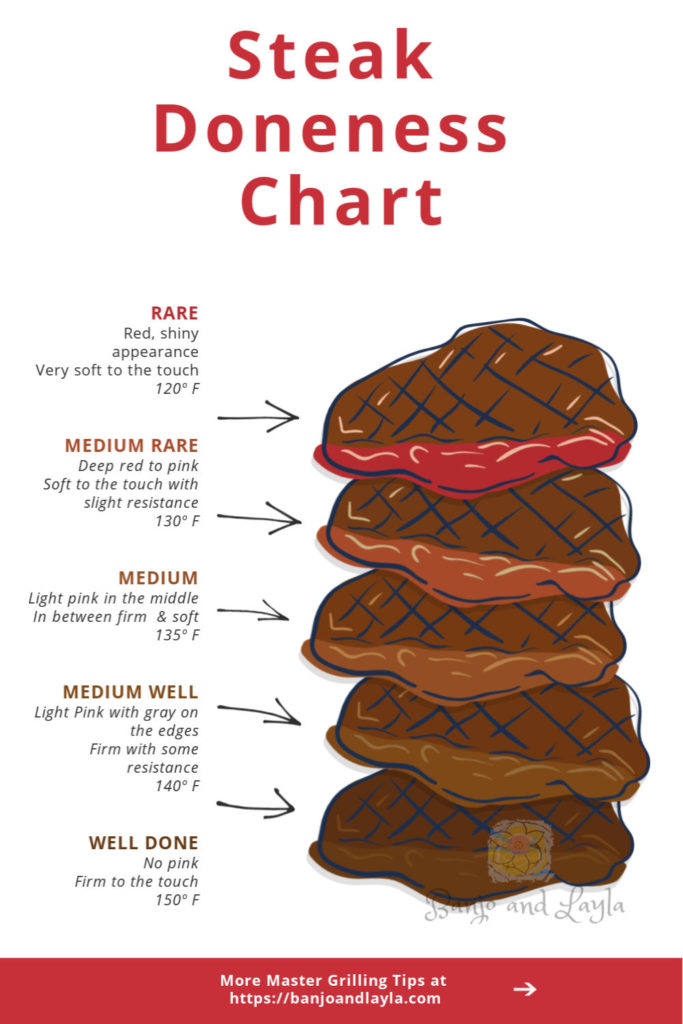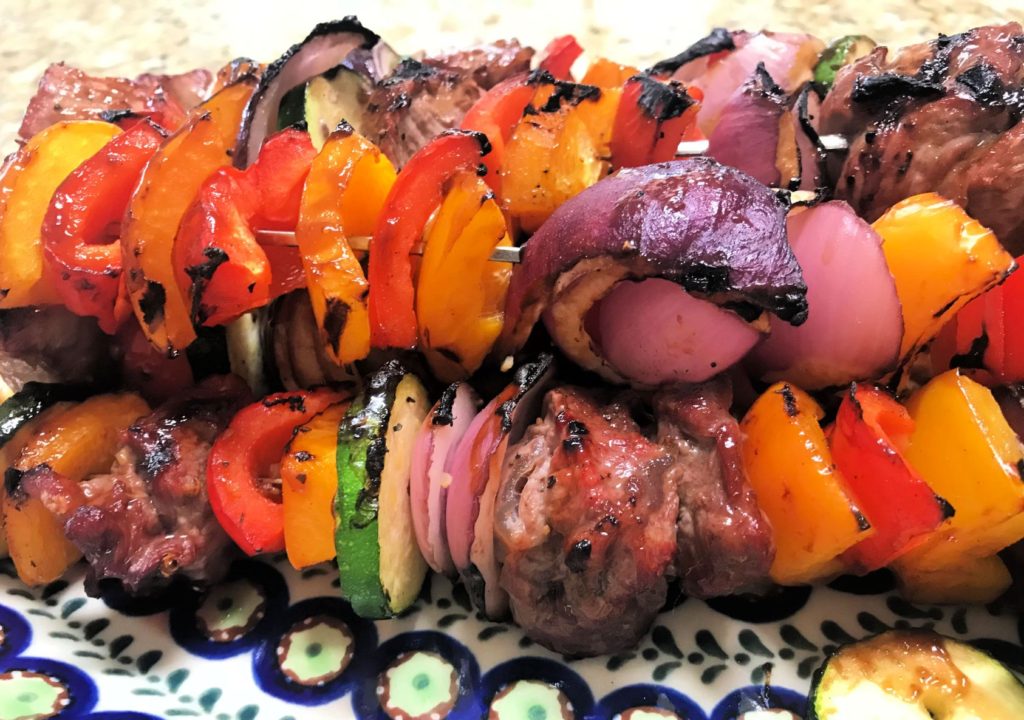
Do you love steak? Summer is in full swing, and it is time to fire up that grill. Steak kabobs are a fun way to grill steak that everyone loves. Juicy tender pieces of beef, marinaded for extra flavor and threaded in between layers of colorful fresh veggies look great on the plate and taste delicious. Served with wild rice they have easily become one of our favorite recipes.
Beef Kabobs: An Easy Flavorful Steak Recipe. Try it tonight!
This post may contain affiliate links, and I may earn commission if you click on the links at no additional cost to you.
Beef or steak kabobs are all about the marinade. Ingredients like Worcestershire and soy sauce bring out the best steak flavor when grilling. Marinating it for several hours is best, because it really allows the flavors to soak into the meat, leaving you with that juicy flavor we want in a steak. However, sometimes when in a hurry we have just brushed the marinade on after the kabobs are on the grill and it still tastes great.
This recipe is super easy and does not take as long as it looks. I purchase pre-cut meat sometimes, and that really cuts down on prep time. Beef kabobs are great for cookouts and parties or just for your family at home. Plan on two skewers per person, and you will always have enough. They taste great as leftovers as well!

Ingredients Needed:
- Olive oil
- Sirloin Steak – New York strip or top sirloin (not petite) works best. These thick lean cuts have great flavor without excess fat. They will be very tender after being marinaded and cooked properly.
- Fresh vegetables – In the picture I used red and yellow peppers, red onion, and zuchinni, but you can use any veggie you like. Mushrooms and tomatoes work well also.
- Soy sauce
- Garlic Powder
- Lemon juice
- Worcestershire sauce
- Brown sugar
- Ground ginger
- Cornstarch
- Honey (optional) – I don’t use it, as I think the brown sugar provides enough sweetness.
- Water
- Salt and Pepper
How to Make Steak Kebabs
1. Make the Marinade
Combine the water, Worcestershire, olive oil, soy sauce, lemon juice, ginger, brown sugar, honey (optional) and garlic powder in a saucepan over medium heat. Cook about 1 minute until nearly heated through.
Mix cornstarch and 1/4 cup water together in a cup or small bowl and stir until dissolved. Add to the saucepan. Cook and stir sauce until thickened, about 6 minutes. Allow the marinade to completely cool before using it.
2. Marinate the Steak
Cut the meat into uniform sizes if possible so that the pieces cook evenly. The best way I’ve found to marinate meat, especially if it’s cut up into small pieces is to place the steak into a gallon size resealable bag and pour the marinade over the meat. Seal the bag tightly while pressing out excess air. Use your hands to sort of rub the marinade over the steak through the bag to make sure all parts are covered. Warning: Make sure that the marinade has completely cooled before you pour it into the bag!
Allow the meat to marinate in the refrigerator 3 – 6 hours. This is not something you want to marinate over night. If you soak it much longer than 6 hours it gets a little mushy. The acidity of the marinade starts to break the meat down, and you don’t want that.
3. Preheat Grill and Prep Food
Preheat the grill to about 425 degrees. We love our Charbroil charcoal grill. Pour a little oil on some paper towels and use them to clean the grill grates before they get too hot.
Cut up the vegetables into large pieces, toss with oil, then sprinkle with garlic powder, salt and pepper, or your seasoning of choice.
Thread each skewer with even layers of steak and vegetables. I put three steak pieces on each kabob. I use reusable metal skewers, but if you use bamboo ones make sure you soak them in water for at least 30 minutes before using or they will burn. When threading the skewers, leave a little space for the heat to circulate. This will allow your vegetables to soften up a little and cook evenly.
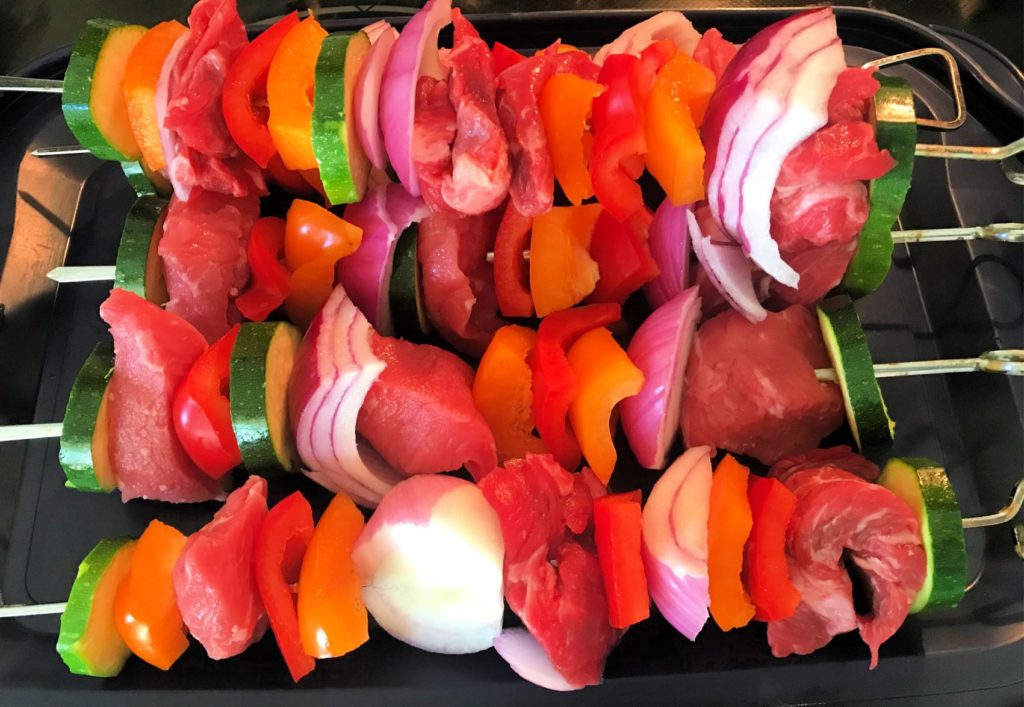
4. Cook the Kabobs
You can brush the grill grates lightly with oil if you want to keep the kabobs from burning, but we find that there is usually enough oil left on the grates from cleaning them that you don’t need to add any more.
Place the kabobs on the grill and cook until the center of the steak is about 140 – 145 degrees for medium doneness, a little more if you want them more done. Brush a little left over marinade on the entire kabob in the beginning stages of cooking. Turn the kabobs occasionally for even grilling. Grilling time will be about 9 minutes.
Don’t overcook them! Keep in mind that grill times vary. Factors such as how close the flames are and the wind make a difference, so keep a close eye on them and don’t leave the grill. No one wants to eat dried up steak!

5. Serve steak kabobs warm.
Serve the steak kabobs warm with a side of wild rice. They do not need any additional seasoning such as salt and pepper before serving as the flavors of the marinade are just enough.
Can I Cook Beef Kabobs in the Oven?
You can cook steak kabobs in the oven, but in my opinion they will have much better flavor if you cook them on the grill. But if you have run out of charcoal or it is pouring down rain, just line a baking sheet with foil, spray it with non-stick spray and cook the kabobs in the oven on 425 degrees for about 10 – 13 minutes. Use a meat thermometer if you are not sure about doneness, and turn them once half way through.
Did you try it? Let me know how it turned out!
Steak Kabobs
Ingredients
- 1/4 cup olive oil
- 2 1/2 Tbsp Worcestershire sauce
- 1/4 cup soy sauce
- 1 1/2 Tbsp lemon juice
- 1 Tbsp minced garlic (+ garlic powder to season veggies)
- 1 1/4 cup water
- 5 tsp packed brown sugar
- 1 Tbsp honey (optional)
- 1/2 tsp ground ginger
- 2 Tbsp cornstarch
- 1 3/4 lbs Top sirloin steak (thick), cutinto 1 1/4 inch pieces
- 1 red onion cut into 1 1/4 inch pieces
- 2 bell peppers mixed colors, cut into pieces
- 1 zuchini cut into 1 1/4 inch pieces
- salt and pepper
Instructions
- Make the Marinade:Combine the water, Worcestershire, olive oil, soy sauce, lemon juice, ginger, brown sugar, honey (optional) and garlic powder in a saucepan over medium heat. Cook about 1 minute until nearly heated through. Mix cornstarch and 1/4 cup water together in a cup or small bowl and stir until dissolved. Add to the saucepan. Cook and stir sauce until thickened, about 6 minutes. Allow the marinade to completely cool before using it.
- Marinate the Steak:Cut the meat into uniform sizes if possible so that the pieces cook evenly. Place the steak into a gallon size resealable bag and pour the marinade over the meat. Seal the bag tightly while pressing out excess air. Use your hands to sort of rub the marinade over the steak through the bag to make sure all parts are covered. Warning: Make sure that the marinade has completely cooled before you pour it into the bag!Allow the meat to marinate in the refrigerator 3 – 6 hours (no more than 6 hours).
- Preheat Grill and Prep Food:Preheat the grill to about 425 degrees. We love our Charbroil charcoal grill. Pour a little oil on some paper towels and use them to clean the grill grates before they get too hot. Cut up the vegetables into large pieces, toss with oil, then sprinkle with garlic powder, salt and pepper, or your seasoning of choice. Thread each skewer with even layers of steak and vegetables leaving some space in between. I put three steak pieces on each kabob. NOTE: If you are using bamboo skewers make sure you soak them in water for at least 30 minutes or they will burn.
- Cook the Kabobs:Brush the grill grates lightly with oil.Place the kabobs on the grill and cook until the center of the steak is about 140 – 145 degrees for medium doneness, a little more if you want them more done. Brush a little left over marinade on the entire kabob in the beginning stages of cooking. Turn the kabobs occasionally for even grilling. Grilling time will be about 9 minutes. Don't overcook them!
- Serve Steak Kabobs Warm. Enjoy!

